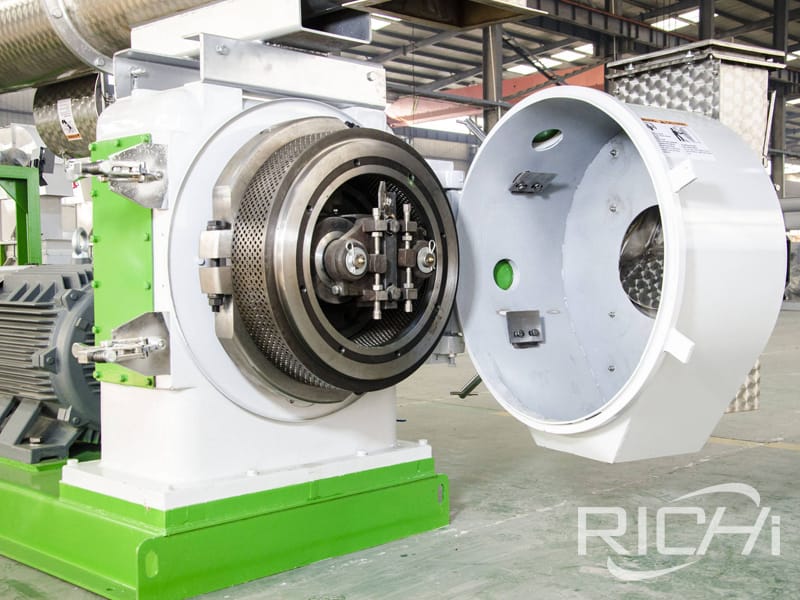Ring die pellet machine, also known as ring die pellet feed machine, ring die pellet feed making machine), belongs to feed pelleting equipment. It is a feed processing machine that directly crushes granules with crushed materials such as corn, soybean meal, straw, grass, and rice husks. The ring die pelletizer is the main feed machinery and equipment for producing pellet feed. Its performance largely determines the output of feed processing and occupies a very important position in the feed processing process.

How to choose the high quality feed pellet mill? The pellet ring die is the one of the key elements that needs to be thought of. The characteristics of the ring die defines the quality of the pellet mills.
The ring die is the heart of the pellet mills in the pellet forming operation. Although both flat dies and ring dies may be used to produce biomass pellets, for large plants the ring die is generally more advantageous. This is due to two reasons:
1.The roller and ring die wear evenly since both edges move the same distance during the production.This causes the wear to occur more evenly, thus saving on the need for replacement parts.
2.Ring dies are more energy efficient for large scale production. Roller slip occurs more often in flat die feed mills, a process that increases friction between the ring die and roller, consuming more energy in the process.
Many characteristics of the ring die can be varied to get the desired results on a particular formulation. Often one must review ring die characteristics with the feed pellet mill supplier to find a solution to a specific problem.
1. Diameter and effective thickness: The key characteristics of the ring die include the diameter of its holes, its effective thickness—which ultimately determines the length of the pellet—and the ratio of these two variables. Each raw material has its own optimal length to diameter ratio. Denser materials, like wood, generally require smaller length to diameter ratios than less dense materials such as straw. One cannot indiscriminately change formulation without changing pellet quality. Besides providing a means of discussing any particular feedstock and its relationship to ring die requirements, this concept gives the ability to scale up or down in pellet size and be sure of having essentially the same quality and production criteria.
2. Total thickness: Another ring die characteristic is its total thickness. In many instances the overall thickness of the ring die must be greater than the effective length because of stresses within the ring die from pelletization. The overall thickness of the ring die is required to withstand the structural stresses of the operation. The thicker the ring die, the stronger it is. Normal ring die thicknesses range from under 1 centimeter to nearly 13 centimeters.
3. Counterbore depth: This is the difference between the total thickness and effective length of the ring die. A ring die is counterbored by taking a larger drill and drilling in from the outside of the ring die, relieving the pressure of the ring die on the material. Counterbores can be supplied either with a tapered bottom or with a square bottom. In some special feed milling and industrial applications, there is excessive expansion of the material as the pellet leaves the hole. A tapered counterbore is effective in minimizing a material's tendency to hang up in the counterbore and eventually form a pellet equal to the counterbore diameter. Certain materials may also require a tapered counterbore to gradually relieve the pressure of the material as it exits the hole. This can improve pellet quality for certain materials.
4. Inlet diameter: The majority of the ring dies produced have a tapered inlet to ease the flow of material into the hole. This taper also begins to compress the material as it enters the hole, thereby doing work on the material.
5. Inlet angle: This is normally a degrees on small-hole ring dies and just eases the feed into the hole. The ring die will eventually wear to its own angle after it has been in production, so the taper is normally supplied at just the start of the flow until the die begins to wear. In certain instances, where operator control is difficult, ring dies can be counterbored differently to minimize the potential for peening. Furthermore, the hole pattern of a ring die can be varied to improve productivity or increase abrasion resistant quantities. It also can be modified to add strength. The alloy of the ring die can be varied to produce maximum life. A variety of stainless steel ring dies are used in pelleting formulations carrying corrosive ingredients. Heat treating the ring die brings out specific properties and varies according to specific application, depending on whether abrasion resistance or toughness would be a major criterion.
Of course, in addition to the ring die, there are many factors that need to be considered when purchasing a ring die pellet feed granulator. Customers still have to choose a ring die pelletizer based on budget and actual application. For more details about the animal poultry chicken cow rabbit broiler feed pellet mill, please contact Richi Machinery for detailed consultation!


